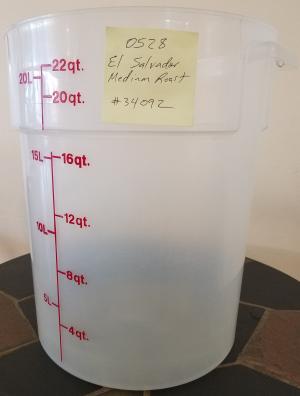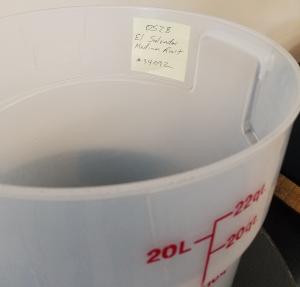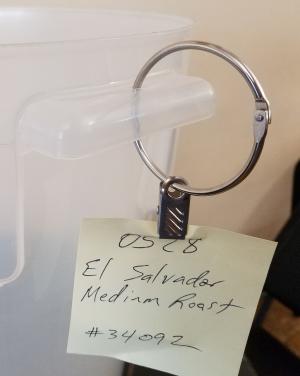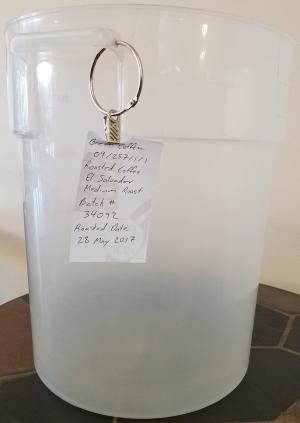 Typica: Software for Coffee Roasting Operations
Typica: Software for Coffee Roasting Operations
 Typica: Software for Coffee Roasting Operations
Typica: Software for Coffee Roasting Operations
There are a lot of roasters that talk about traceability in the context of knowing where the coffee they buy is coming from and where the money they pay for that coffee is going to. That can be important when making sure that the supply chain you rely on is sustainable and the things that you learn through that work can be helpful in marketing, but the benefits of traceability don't stop when the green coffee gets delivered to your facility, and some of those benefits can be lost if you aren't prepared to continue that traceability through your production operations to the finished product. What's the point of knowing what farm produced your lovely Nicaraguan coffee if you're selling that with a label that says it's from Mexico?
Key to traceability in production is to make sure that everything is always labeled and that these labels can be connected to production documentation. This is an area where technology like Typica can be very helpful. If you have a database that stores what green coffee was used to produce which batches of roasted coffee, how those roasted coffees were used in blends, and what customers purchased specific production lots, it's possible to periodically review that data and make sure that it makes sense. For example, if you have coffee that's covered under a certification program with an audit requirement, it's great to be able to show that you didn't roast more of the green coffee than you purchased and that you didn't sell more of the roasted coffee than you produced. Auditors love to see a good production database integrated into your production processes, especially if it's clear that this is something that's always being used for every coffee and not some ad hoc process that's only used where there's an audit requirement. If an issue is identified where it makes sense to conduct a product recall, knowing where that roasted coffee went and being able to communicate clear identifying information for the specific lots affected can make that recall much more targeted and consequently less expensive to conduct.
A problem with this is that many of the buckets that roasters use for moving green and roasted coffee through these production processes are not well suited for attaching any kind of documentation, especially at smaller companies. Let's take a look at some options here.

This is a typical food safe bucket. It can hold about 30 pounds of green coffee or about half as much roasted coffee. How would you label this? You don't want anything permanent because that doesn't allow documenting things that change with every batch of a specific coffee, it's less flexible to changes in which coffees are part of the product line or to sudden increases in demand for a particular coffee, and it's really just all around better if the buckets can remain interchangeable while they're empty.

You could tape your tags or use sticky notes on the outside of the bucket. The problem with this is that adhesive sometimes doesn't do a very good job and those tags will fall off. Maybe you'll be able to figure out what tag should have been on the bucket, but it's very easy to lose information about the coffee at this point. If you're using a stickier tape, chances are good that's leaving some hard to clean adhesive residue on the buckets as well. With training and diligence, it's possible to make this work, but it's not a very good solution.

Okay, why not put the tag on the inside of the bucket? That way, if the tag falls off, it will at least fall into the bucket and still be with the coffee. If tags are falling into the bucket, that's going to get in the way of blending or bagging. People will take the tags out of the buckets. If they're staying at their work station and using all of the coffee, that's not a problem, but if that's someone who might be going back and forth between bagging and bar work, it's incredibly easy to remove the tag, forget to put it back, and forget what they were working on. Another problem is that if there's a non-transparent lid on the bucket, you now have to remove the lid to see what coffee you have. Again, it's possible to make this work, but it's inconvenient and easy to make mistakes. Can we do better?

Let's take a closer look at that bucket. In the center of the handles there's a hole. What if we took a book ring, put it through the hole, and added a bag clip? That can hold the tag more firmly than a sticky note, doesn't leave the hard to clean residue of tape, and chances are good you can make your tags less expensive as well. The problem with this is that if you do that, it's hard to use the handle as a handle and the ring might get in the way of putting a lid on the bucket. That's still not a good solution, but it is on the right track. The problem isn't so much with the idea of adding a clip, but that the center of the top of the handle is about the worst place you could pick to put that hole.

What if there were a hole in the side of the handle? This would allow placing a book ring in such a way that it's not rising into the space where a lid would go on the bucket and it leaves most of the handle available to use as a handle. It preserves the benefits of clips and of having tags on the outside of the bucket while remaining easy to clean. While buckets don't typically come with a hole in the handle anywhere that's really useful, that's nothing that a small drill can't fix.
Using Typica and this inexpensive bucket modification gets you a long way toward having good production traceability and I'm working on features for a future release that makes this even easier. The more that data entry can be automated or simply be an integrated part of a production task, the more likely it is that this will be done properly. Non-integrated computer or paper based record systems are easier to ignore, making the data that is collected in them less trustworthy. Having all of that information in a database makes it easier to get at the information that you're interested in, makes it easier to get useful reports that can provide benefits beyond just traceability, and makes it easier to flag potential issues before the coffee reaches a customer.